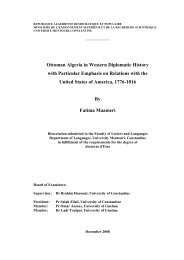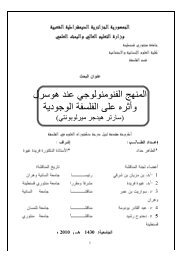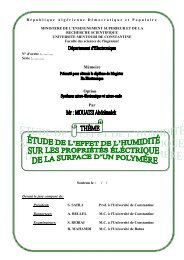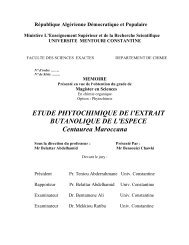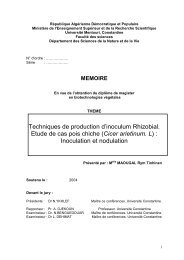(Thèse partie 1)
(Thèse partie 1)
(Thèse partie 1)
You also want an ePaper? Increase the reach of your titles
YUMPU automatically turns print PDFs into web optimized ePapers that Google loves.
187<br />
Références bibliographiques<br />
Reistad, R. (1974). 2-Amino-2-deoxyglucuronic acid: a constituent of the cell wall of<br />
Halococcus sp., strain 24. Carbohyd Res 36, 420-425.<br />
Rainey, F., Zhilina, T., Buligyna, E., Stackebrandt, E., Tourova, T. & Zavarzin, G.<br />
(1995). The taxonomic statut of the fermentative halophilic anaerobic bacteria. Anaerobe 1,<br />
185-189.<br />
Rodriguez-Valera, F., Ruiz-Berraquero, F. & Ramos-Cormenzana, A. (1980). Isolation<br />
of Extremely Halophilic Bacteria Able to Grow in Defined Media with Single Caron Sources.<br />
J Gen Microbiol 119, 535-538.<br />
Rodriguez-Valera, F., Ruiz-Berraquero, F. & Ramos-Cormenzana, A. (1981).<br />
Characteristics of the heterotrophic bacteria populations in hypersaline environments of<br />
differing salinities. Microbiol Ecol 7, 335-243.<br />
Rodriguez-Valera, F., Juez, G. & Kushner, D. J. (1982). Halocins: Salt-dependant<br />
bacteriocins produced by extremely halophilic rods. Can J Microbiol 28, 151-154.<br />
Rodriguez-Valera, F., Juez, G. & Kushner, D. J. (1983). Halobacterium mediterranei sp.<br />
nov., a new carbohydrate-utilizing extreme halophile. Syst Appl Microbiol 4, 369-381.<br />
Rodriguez-Valera, F., Ventosa, A., Juez, G. & Imhoff, J. F. (1985). Variation of<br />
environmental features and microbial populations with salt concentrations in a multi-ponds<br />
saltern. Microb Ecol 11, 107-115.<br />
Rodriguez-Valera, F. & Lillo, J. G. (1992). Halobacteria as producers of<br />
polyhydroxyalkanoates. FEMS Microbiology Rev 103, 181-186.<br />
Rodriguez-Valera, F. (1993). Introduction to Saline Environments. In The Biology of<br />
Halophilic Bacteria. Eds. R. H. Vreeland & L. I. Hochstein. pp.1-23. CRC Press Inc, Boca<br />
Raton.<br />
Rodriguez-Valera, F., Acinas, S. G. & Antøn, A. (1999). Contribution of Molecular<br />
Techniques to the Study of Microbial Diversity in Hyperssaline Environments. In<br />
Microbiology and Biogeochemistry of Hypersaline Environments. Ed. A. Oren. pp. 27-36.<br />
CRC Press, Boca Raton. London, New York, Washington D. C.<br />
Rodriguez-Valera, F. (2002). Approaches to prokaryotic biodiversity: a population genetics<br />
perspective. Environ Microbiol 4, 628-633.<br />
Romanenko, A. L., Schumann, P., Rohde M., Zhukova, N. V., Mikhailov, V. V. &<br />
Stackebrandt, E. (2002). Halomonas halocynthiae sp. nov., isolated from the marine<br />
ascidian Halocynthia aurantum. Int J Syst Evol Microbiol 52, 1767-1772.<br />
Romanenko, A. L., Schumann, P., Rohde M., Zhukova, N. V., Mikhailov, V. V. &<br />
Stackebrandt, E. (2005). Marinobacter bryozoorum sp. nov. and Marinobacter sediminum<br />
sp. nov., novel bacteria from the marine environment. Int J Syst Evol Microbiol 55, 143-148.<br />
Romano, I., Nicolaus, B., Lama, L., Manca, C. & Gambacorta, A. (1996).<br />
Characterieation of haloalkalophilic strictly aerobic bacterium, isolated from Pantelleria<br />
island. Syst Appl Microbiol 19, 326-333.<br />
Rose, R. W., Brüser, T., Kissinger, J. C. & Pohlschröder, M. (2002). Adaptation of protein<br />
secretion to extremely high-salt conditions by extensive use of the twin-arginine translocation<br />
pathway. Mol Microbiol 45, 943-950.<br />
Ross, H. N. M. & Grant, W. D. (1985). Lipids in Archaebacterial Taxonomy. In Chemical<br />
Methods in Bacterial Systematics. Eds. M. Goodfellow & D. E. Minnikin. pp. 289-300.<br />
Academic Press..<br />
Rosselló-Mora, R. & Amann, R. (2001). The species concept for prokaryotes. FEMS<br />
Microbiol Rev 25, 39-67.<br />
Ruepp, A. & Soppa, J. (1996). Fermentative Arginine Degradation in Halobacterium<br />
salinarum (formerly Halobacterium halobium): Genes, Gene products, and Transcripts of the<br />
arcRACB cluster. J Bacteriol 178, 4942-4947.



